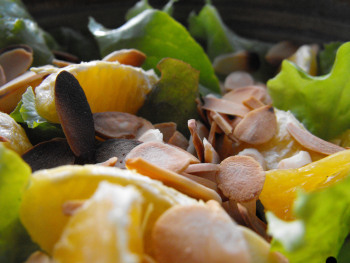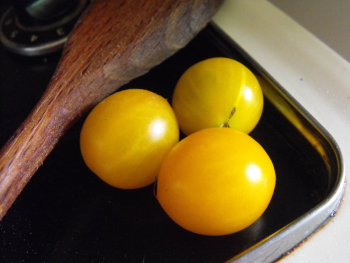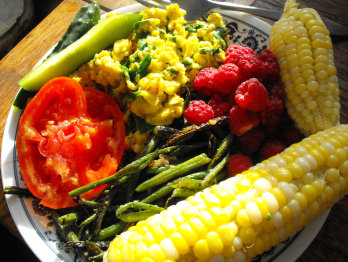
Simple recipes for simple vegetables
 If
you take my advice and plant a few of the easy vegetables
mentioned in
my last post, you will quickly be overrun with fresh produce. Now
what do you do with it?
If
you take my advice and plant a few of the easy vegetables
mentioned in
my last post, you will quickly be overrun with fresh produce. Now
what do you do with it?
First of all, it's
essential that you get over the grocery store
mentality that a slight blemish means a vegetable gets tossed in the
trash. Your vegetables may have a bug nibble here and there, or
even a crack in the side. Don't worry about it. I can't for
the life of me find a link, but I was recently told about a sect of
monks who were quite healthy vegans until they began to buy commercial
produce and came down with nutritional deficiencies. It turned
out that the insects they were accidentally ingesting in their previous
diet of non-commercial vegetables had been keeping them healthy.
I don't wash our homegrown produce, and we find it delicious, bugs,
dirt, blemishes, and all.
 Chances
are, once you discover how good your homegrown vegetables
taste, a good amount of the bounty won't even make it out of the
garden. Eventually, you'll probably want to present the
vegetables as part of the meal, which is the purpose of this
post. Tomorrow I'll
give you pointers on becoming a bit fancier.
Chances
are, once you discover how good your homegrown vegetables
taste, a good amount of the bounty won't even make it out of the
garden. Eventually, you'll probably want to present the
vegetables as part of the meal, which is the purpose of this
post. Tomorrow I'll
give you pointers on becoming a bit fancier.
Lettuce - By the time fresh
tomatoes and cucumbers reach my plate, lettuce is long gone, which
blows my traditional salad out the window. Here are some in-season salad ideas.
Swiss
chard - The
easiest way
to prepare stellar greens is to cut them into bite-size pieces and
steam them for a few minutes until the stems are soft. Drizzle
them with balsamic vinegar and eat. Once you get bored with that,
try sauteing the greens in a large pot in a bit of oil, adding minced
garlic for the last minute of cooking.
Tomatoes - Once you get sick of just
eating tomato slices (if ever), try our cucumber and tomato salad. Some people add goat
cheese and/or mozarella to the mix for a heartier salad.
 Basil - Pesto is the obvious
solution to an overdose of basil. I've posted my recipe for chestnut pesto, but we usually use walnuts
in our daily lives. Pine nuts are the classic pesto component,
but are extremely pricey.
Basil - Pesto is the obvious
solution to an overdose of basil. I've posted my recipe for chestnut pesto, but we usually use walnuts
in our daily lives. Pine nuts are the classic pesto component,
but are extremely pricey.
Sweet
corn - In my
opinion, the
only way to eat sweet corn is to very lightly cook it. Bring a
big pot of water to a boil while you shuck the corn, then drop the ears
in for less than a minute, just until they change color.
Carefully pull them out with a pair of tongs and eat immediately (with
salt and/or butter if you prefer.)
Okra - I already mentioned that I
prefer steaming okra, and that most people fry it. What's your
favorite way to eat okra?
Whatever you do,
remember that freshness is key. As soon as you
pick an ear of corn, the sugars begin to turn to starches and the
flavor declines. Although the difference isn't quite as
pronounced with other vegetables, the trend is the same. For
maximum flavor and nutrition, pick produce right before eating it.
| This post is part of our Beginner's Guide to Gardening and Eating in
Season lunchtime series.
Read all of the entries: |
Want more in-depth information? Browse through our books.
Or explore more posts by date or by subject.
About us: Anna Hess and Mark Hamilton spent over a decade living self-sufficiently in the mountains of Virginia before moving north to start over from scratch in the foothills of Ohio. They've experimented with permaculture, no-till gardening, trailersteading, home-based microbusinesses and much more, writing about their adventures in both blogs and books.
Want to be notified when new comments are posted on this page? Click on the RSS button after you add a comment to subscribe to the comment feed, or simply check the box beside "email replies to me" while writing your comment.

I slice the tops off very carefully, so as not to cut into the pod itself. Then I put oil in a skillet and pan-fry the okra with curry masala spices. I like to get it good and browned. It's delicious and it avoids the sliminess some people can't handle.
Last year we had so much okra that I pickled most of it. Delish -- and put lots of peppers and garlic in, too, 'cause those are good pickled as well.
I can't wait for okra this year!
Ingredients:
Preparation: Combine chicken, the onion chunks, celery leaves, and salt in a Dutch oven or large kettle; add water to cover. Bring to a boil; cover, reduce heat, and simmer about 45 minutes. or until chicken is tender. Remove chicken, reserving 5 cups of the chicken broth; discard onion and celery leaves. Remove chicken from bones; cut into bite sized pieces. Set aside.
Cook bacon and sausage in a large Dutch oven over medium heat until bacon is crisp. Remove bacon and sausage, reserving 1 tablespoon drippings in Dutch oven. Crumble bacon; set bacon and sausage aside. Add onion, pepper, celery, and garlic to Dutch oven; cook over medium heat, stirring constantly, until vegetables are tender. Add chicken, bacon, sausage, reserved broth (should be approximately 5 cups), tomatoes, and remaining ingredients. Bring mixture to a boil; reduce heat, and simmer, uncovered, 1 1/2 hours.